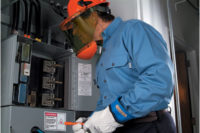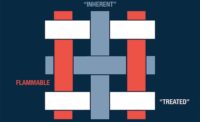However, it is important to understand that these standards are designed to represent a minimum performance criteria; they are intended to be used as the starting point, not the finish line, when evaluating FR clothing.
Both ASTM F-1506 and NFPA 2112, along with fabric brand(s) and weights, should be among the first things specified when creating an FR program. If a flame-resistant product for arc flash or flash fire protection cannot pass these standards, it simply doesn’t belong on your employees. On the other hand, just because an FR product may easily pass, it does not necessarily make it your best protection option.
Flash fire protection
NFPA 2112Standard on Flame-Resistant Garments for Protection of Industrial Personnel Against Flash Fireis an excellent comparative tool for FR garment performance in flash fire, providing more relevant and better information than either vertical flame or TPP testing. It sets a minimum performance bar; to pass 2112, a garment must record less than 50 percent body burn (2nd and 3rd degree) on an instrumented manikin in a three-second exposure, which is defined as the upper limit of flash fire duration. Body burn of less than 50 percent is significantly less likely to lead to fatality than more extensive burn injuries, so it’s easy to see the value of this standard.It’s also apparent, however, that a product can pass with 49 percent body burn, 25 percent body burn or 1 percent body burn. Burns in the 25-50 percent range will result in weeks or months in the hospital, while burns in the low single digits will usually mean making it home for dinner. Consequently, it is crucial to look beyond mere compliance. Compliance is an excellent qualifier to see what products make the race, but it does not show the winners; the thermal protective performance data does. Best practice is to evaluate products that pass 2112, but examine the actual body burn data and specify from among products at the top of the class, and which also meet your other criteria.
Arc flash protection
ASTM F-1506Standard Performance Specification for Flame Resistant Textile Materials for Wearing Apparel for Use by Electrical Workers Exposed to Momentary Electric Arc and Related Thermal Hazardshas a similar role in evaluation of FR clothing for arc flash. The standard is a valuable asset, and compliance with it is one of the most important aspects of the specification process. 1506 ensures that garments are built with fabrics and threads that are flame-resistant, and that components like zippers, snaps, closures, etc., will not cause additional injury. It also sets minimum bars for fabric strength, seam slippage, colorfastness and laundry durability.So, like 2112, 1506 is an excellent starting point from which to evaluate FR garments for arc flash hazards, but compliance with it should not be the sole determinative factor. Issues to consider include arc rating, FR durability and type of laundering.
Evaluation of garments for arc flash usually begins with ATPV, or arc rating. 1506 requires the product to have an arc rating and that the arc rating appears in the label, but it does not set minimum ratings. Thus, a shirt can be compliant with an ATPV of 4, while another shirt is also compliant but has an ATPV of 8. The shirt that earned an arc rating of 8 cals will provide twice the thermal protection of the shirt with the 4 cal rating.
Durability considerations
Durability of FR properties to laundering over time is also a consideration. 1506 requires that fabrics pass vertical flame both new and after 25 wash/dry cycles per AATCC method 135. While it is good that the standard requires testing of flame resistance after advanced laundering, 25 laundering cycles represents six months to a year of use. But most FR garments worn for arc flash protection will be in service for three to four years. Thus, while compliance ensures a minimal level of FR durability, it does not indicate flame resistance for the service life of the garment.In addition to the number of wash cycles, the laundering itself is also relevant. AATCC 135 uses 120°F water and is essentially a home laundering method; whereas a typical industrial laundry procedure will generally utilize higher temperatures (140 to 165°F) and caustic (high pH) solutions for cleaning. This high pH cleaning will then be followed by rinses and an acid sour, or pH neutralization step. These conditions are much more aggressive (and better cleaners) than home laundering and can potentially rapidly deteriorate the FR properties of some fabrics. Again, it is clear that compliance to ASTM F-1506 alone does not guarantee longevity of FR properties.
In summary, ASTM F-1506 and NFPA 2112 are valuable tools for accurate and impartial evaluation of flame-resistant garments. However, they are minimum performance requirements, and compliance alone does not ensure either superior thermal protection or durability of FR properties.

